by W.S. Cranshaw* (1/20)
Quick Facts…
- Caterpillars of the Zimmerman pine moth damage pine trees by tunneling into the trunks and branches, often causing branches to break.
- Scotch and Austrian pines are particularly susceptible to injury.
- Evidence of injury are pale yellow, popcorn-like masses of sap that develop at in response to feeding wounds.
- Preventive insecticide sprays are effective when applied during periods when the caterpillars are exposed on the surface of the tree.
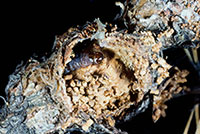 Figure 1: Caterpillar of the Zimmerman pine moth, exposed from the area of a feeding wound. Photograph courtesy of Jim Kalisch, University of Nebraska. |
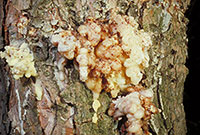 Figure 2: Mass of fresh pitch produced at an area of a Zimmerman pine moth feeding wound. Photograph courtesy of David Shetlar, The Ohio State University. |
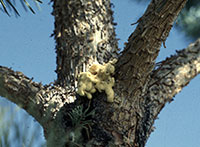 Figure 3: Old hardened pitch masses of Zimmerman pine moth. Feeding wounds are often concentrated at the whorl area where branches join the trunk. |
 Figure 4: Wounds by Zimmerman pine moth structurally weaken trees and may contribute to limb breakage. |
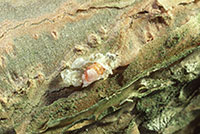 Figure 5: Zimmerman pine moth spends the winter as a young caterpillar within a tiny cocoon, known as a hibernaculum, on the bark of the tree. Photograph courtesy of David Shetlar, The Ohio State University. |
Zimmerman pine moth, Dioryctria zimmermani, is a wood boring insect that has been accidentally introduced into and later established in several areas of Colorado. Certain pines, particularly Austrian and Scotch pines, are particularly susceptible to this insect.
Damage is caused by injuries made when the developing caterpillars tunnel into the trunk and branches, producing irregular gouging wounds under the bark. At areas where insect tunneling occurs, popcorn-like masses of sap ooze and collect on the surface. With recent injuries the sap is soft and can be easily pulled away, often exposing the tunnel of the feeding caterpillar. Hardened sap may remain on the tree for a year or more after the injury has occurred.
Damage usually occurs in the upper part of the tree and feeding is often concentrated at the area where branches meet the trunk. This produces weakening that may result in limbs dying or breaking from the tree. .
The adults, rarely observed, are midsized moths, with gray wings blended with red-brown and marked with zigzag lines. Adults are difficult to distinguish from other members of this genus.
Life History and Habits
The Zimmerman pine moth has a one-year life cycle. Through winter it survives as a first stage caterpillar, sheltered in a tiny cocoon (hibernaculum) attached to the bark surface. In early spring, usually sometime between mid-April and early May, the caterpillar emerges from the cocoon and begins to tunnels the tree.
Tunneling may first occur around the branch tips and within the shoots, sometimes causing twig dieback. Later most will be found at the base of branches, tunneling into the whorl area where branches meet the trunk. The caterpillars are generally dirty white or gray, occasionally with some pink or green. They often can be found underneath masses of freshly produced pitch.
When full-grown, the caterpillars transform to the pupal stage, remaining within the tunnel. Later, the adult moth emerges, typically in late July and August. After mating, female moths lay eggs, often near areas of earlier wounds. The eggs hatch about a week after being laid. The newly hatched caterpillar feeds for a brief period on the surface of the tree, before excavating a shallow pit and spinning the protective cocoon within in which it remains until the following spring.
Control
Zimmerman pine moth can be controlled with insecticides that applied to the surface of the tree during periods when the caterpillars are still on the exterior of the tree. There are no insecticides that can kill the insect after it has tunneled within the tree. On small trees some caterpillars within the tree can be discovered by searching areas of fresh wounds and physically removed or punctured.
Because of the life cycle of Zimmerman pine moth, there are two periods when caterpillars are exposed on the bark and insecticide sprays can be effectively used. One is during the period when eggs are laid and hatching, which may occur over a period of several weeks in late summer. Often a better timing of treatments is in spring, targeting the overwintered caterpillars as they emerge and resume activity, often in mid-late April.
Insecticide sprays should be thoroughly applied to cover all surfaces of the bark where the caterpillars may occur. Spray volumes should be sufficient to thoroughly wet the bark to penetrate areas under bark flakes and around wounded areas.
 Figure 6: Adult of the Zimmerman pine moth. |
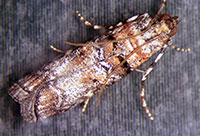 Figure 7: Adult of the Zimmerman pine moth. |
Three insecticides are suitable for control of Zimmerman pine moth, chlorantraniliprole, bifenthrin, and permethrin (Table 1). Only the latter is available in a retail formulation.
Table 1. Insecticides that can be used to control Zimmerman pine moth when applied as sprays during times when young caterpillars are on the bark surface.

1 Colorado State University Extension entomologist and professor, bioagricultural sciences and pest management. 2/99. Revised 1/20.
Colorado State University, U.S. Department of Agriculture and Colorado counties cooperating. CSU Extension programs are available to all without discrimination. No endorsement of products mentioned is intended nor is criticism implied of products not mentioned.
Go to top of this page.





